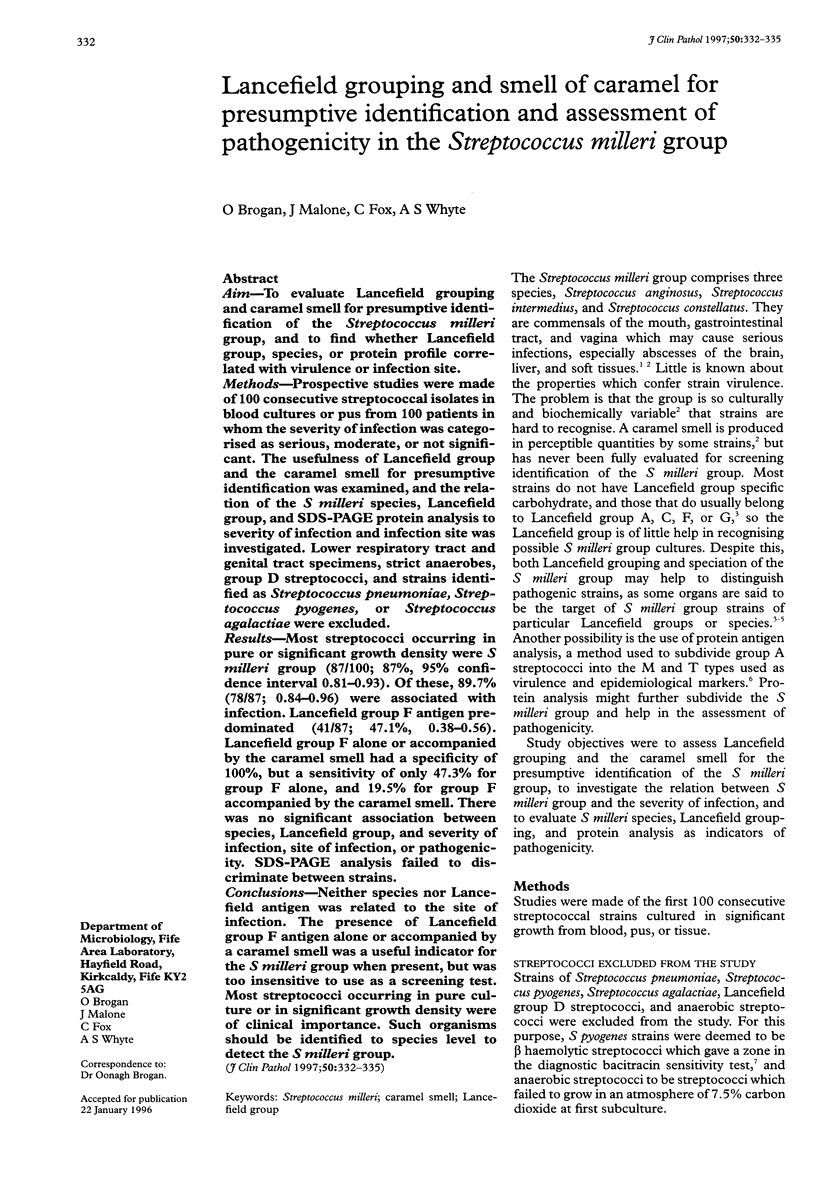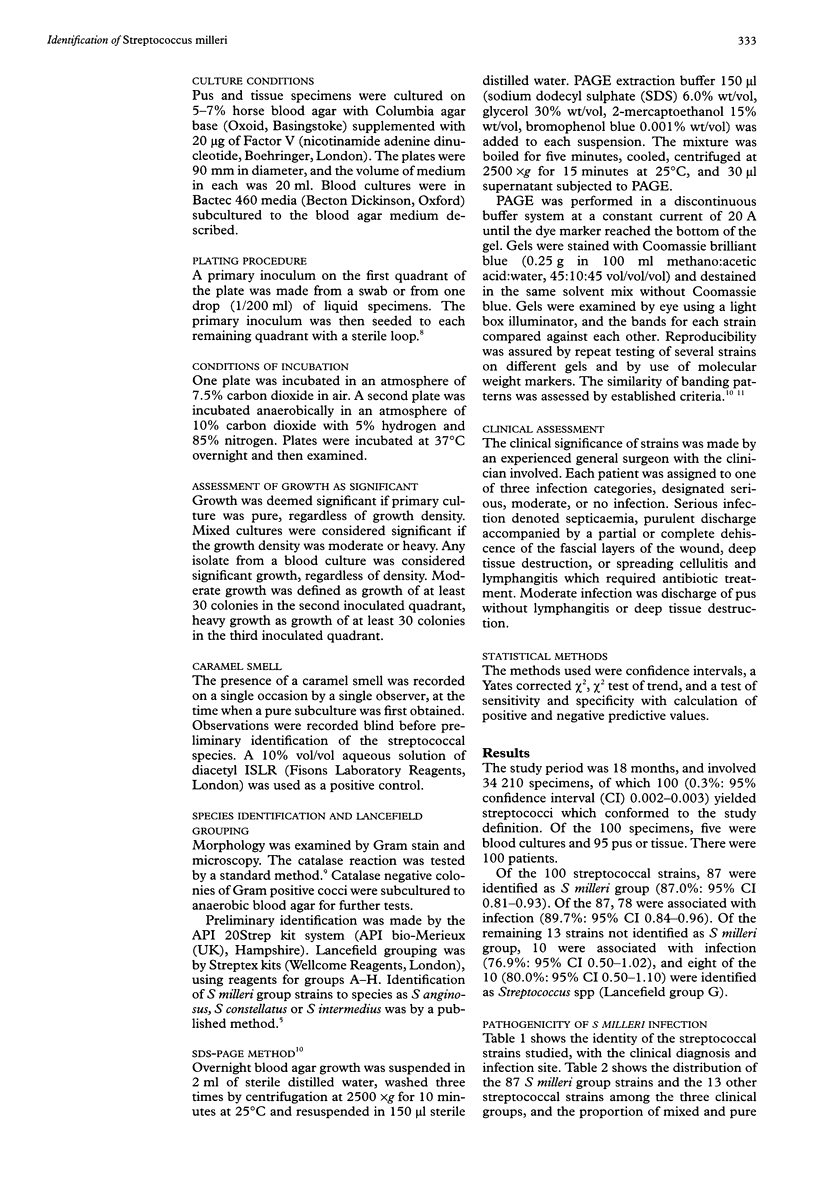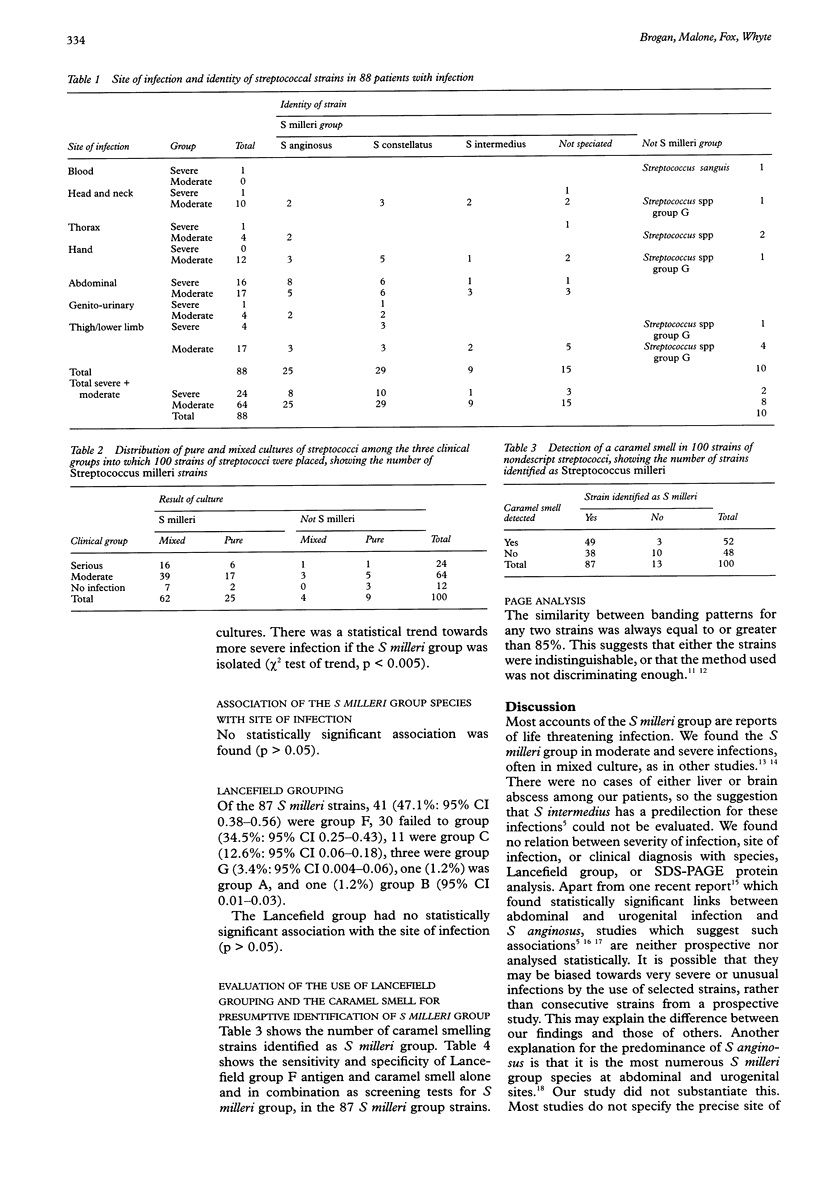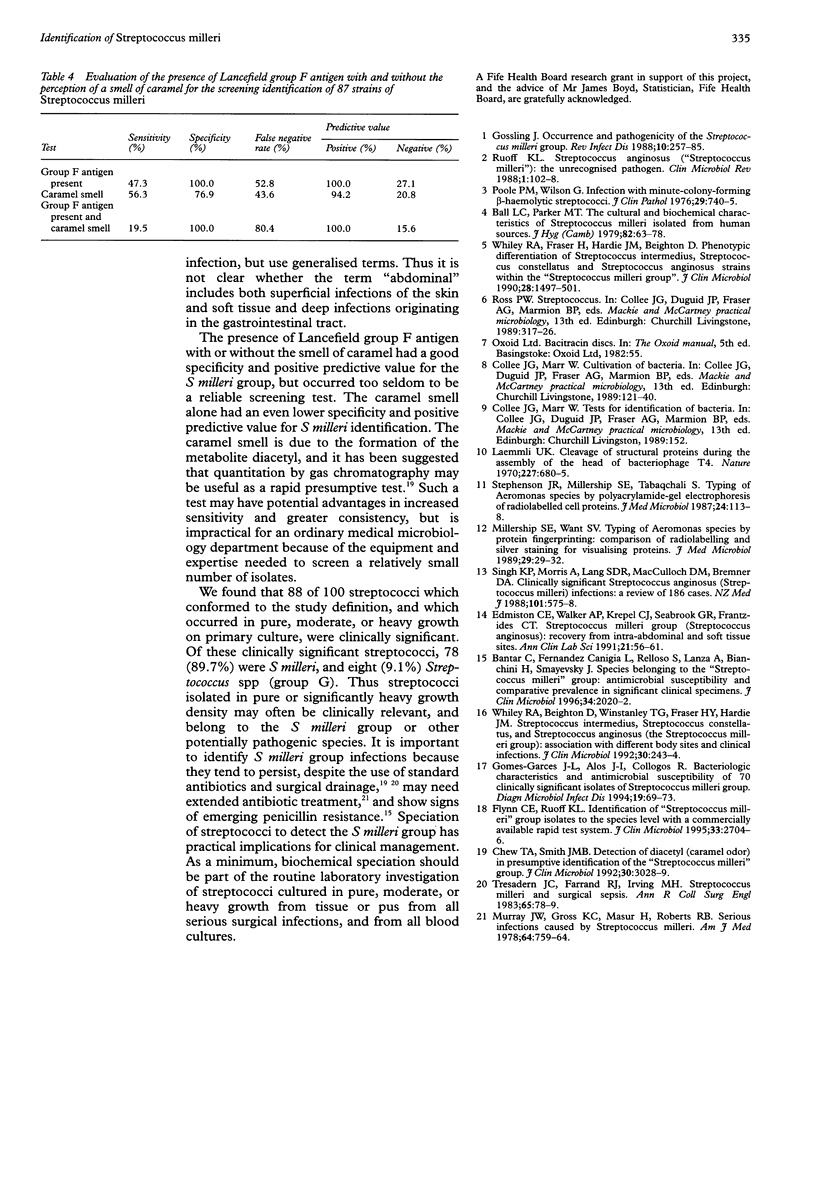Abstract
AIM: To evaluate Lancefield grouping and caramel smell for presumptive identification of the Streptococcus milleri group, and to find whether Lancefield group, species, or protein profile correlated with virulence or infection site. METHODS: Prospective studies were made of 100 consecutive streptococcal isolates in blood cultures or pus from 100 patients in whom the severity of infection was categorised as serious, moderate, or not significant. The usefulness of Lancefield group and the caramel smell for presumptive identification was examined, and the relation of the S milleri species, Lancefield group, and SDS-PAGE protein analysis to severity of infection and infection site was investigated. Lower respiratory tract and genital tract specimens, strict anaerobes, group D streptococci, and strains identified as Streptococcus pneumoniae, Streptococcus pyogenes, or Streptococcus agalactiae were excluded. RESULTS: Most streptococci occurring in pure or significant growth density were S milleri group (87/100; 87%, 95% confidence interval 0.81-0.93). Of these, 89.7% (78/87; 0.84-0.96) were associated with infection. Lancefield group F antigen predominated (41/87; 47.1%, 0.38-0.56). Lancefield group F alone or accompanied by the caramel smell had a specificity of 100%, but a sensitivity of only 47.3% for group F alone, and 19.5% for group F accompanied by the caramel smell. There was no significant association between species, Lancefield group, and severity of infection, site of infection, or pathogenicity. SDS-PAGE analysis failed to discriminate between strains. CONCLUSIONS: Neither species nor Lancefield antigen was related to the site of infection. The presence of Lancefield group F antigen alone or accompanied by a caramel smell was a useful indicator for the S milleri group when present, but was too insensitive to use as a screening test. Most streptococci occurring in pure culture or in significant growth density were of clinical importance. Such organisms should be identified to species level to detect the S milleri group.
Full text
PDF



Selected References
These references are in PubMed. This may not be the complete list of references from this article.
- Ball L. C., Parker M. T. The cultural and biochemical characters of Streptococcus milleri strains isolated from human sources. J Hyg (Lond) 1979 Feb;82(1):63–78. doi: 10.1017/s002217240002547x. [DOI] [PMC free article] [PubMed] [Google Scholar]
- Bantar C., Fernandez Canigia L., Relloso S., Lanza A., Bianchini H., Smayevsky J. Species belonging to the "Streptococcus milleri" group: antimicrobial susceptibility and comparative prevalence in significant clinical specimens. J Clin Microbiol. 1996 Aug;34(8):2020–2022. doi: 10.1128/jcm.34.8.2020-2022.1996. [DOI] [PMC free article] [PubMed] [Google Scholar]
- Chew T. A., Smith J. M. Detection of diacetyl (caramel odor) in presumptive identification of the "Streptococcus milleri" group. J Clin Microbiol. 1992 Nov;30(11):3028–3029. doi: 10.1128/jcm.30.11.3028-3029.1992. [DOI] [PMC free article] [PubMed] [Google Scholar]
- Edmiston C. E., Jr, Walker A. P., Krepel C. J., Gohr C. M., Seabrook G. R., Frantzides C. T. Streptococcus milleri group (Streptococcus anginosus): recovery from intra-abdominal and soft tissue sites. Ann Clin Lab Sci. 1991 Jan-Feb;21(1):56–61. [PubMed] [Google Scholar]
- Flynn C. E., Ruoff K. L. Identification of "Streptococcus milleri" group isolates to the species level with a commercially available rapid test system. J Clin Microbiol. 1995 Oct;33(10):2704–2706. doi: 10.1128/jcm.33.10.2704-2706.1995. [DOI] [PMC free article] [PubMed] [Google Scholar]
- Gossling J. Occurrence and pathogenicity of the Streptococcus milleri group. Rev Infect Dis. 1988 Mar-Apr;10(2):257–285. doi: 10.1093/clinids/10.2.257. [DOI] [PubMed] [Google Scholar]
- Gómez-Garcés J. L., Alós J. I., Cogollos R. Bacteriologic characteristics and antimicrobial susceptibility of 70 clinically significant isolates of Streptococcus milleri group. Diagn Microbiol Infect Dis. 1994 Jun;19(2):69–73. doi: 10.1016/0732-8893(94)90115-5. [DOI] [PubMed] [Google Scholar]
- Laemmli U. K. Cleavage of structural proteins during the assembly of the head of bacteriophage T4. Nature. 1970 Aug 15;227(5259):680–685. doi: 10.1038/227680a0. [DOI] [PubMed] [Google Scholar]
- Millership S. E., Want S. V. Typing of Aeromonas species by protein fingerprinting: comparison of radiolabelling and silver staining for visualising proteins. J Med Microbiol. 1989 May;29(1):29–32. doi: 10.1099/00222615-29-1-29. [DOI] [PubMed] [Google Scholar]
- Murray H. W., Gross K. C., Masur H., Roberts R. B. Serious infections caused by Streptococcus milleri. Am J Med. 1978 May;64(5):759–764. doi: 10.1016/0002-9343(78)90514-4. [DOI] [PubMed] [Google Scholar]
- Poole P. M., Wilson G. Infection with minute-colony-forming beta-haemolytic streptococci. J Clin Pathol. 1976 Aug;29(8):740–745. doi: 10.1136/jcp.29.8.740. [DOI] [PMC free article] [PubMed] [Google Scholar]
- Ruoff K. L. Streptococcus anginosus ("Streptococcus milleri"): the unrecognized pathogen. Clin Microbiol Rev. 1988 Jan;1(1):102–108. doi: 10.1128/cmr.1.1.102. [DOI] [PMC free article] [PubMed] [Google Scholar]
- Stephenson J. R., Millership S. E., Tabaqchali S. Typing of Aeromonas species by polyacrylamide-gel electrophoresis of radiolabelled cell proteins. J Med Microbiol. 1987 Sep;24(2):113–118. doi: 10.1099/00222615-24-2-113. [DOI] [PubMed] [Google Scholar]
- Tresadern J. C., Farrand R. J., Irving M. H. Streptococcus milleri and surgical sepsis. Ann R Coll Surg Engl. 1983 Mar;65(2):78–79. [PMC free article] [PubMed] [Google Scholar]
- Whiley R. A., Beighton D., Winstanley T. G., Fraser H. Y., Hardie J. M. Streptococcus intermedius, Streptococcus constellatus, and Streptococcus anginosus (the Streptococcus milleri group): association with different body sites and clinical infections. J Clin Microbiol. 1992 Jan;30(1):243–244. doi: 10.1128/jcm.30.1.243-244.1992. [DOI] [PMC free article] [PubMed] [Google Scholar]
- Whiley R. A., Fraser H., Hardie J. M., Beighton D. Phenotypic differentiation of Streptococcus intermedius, Streptococcus constellatus, and Streptococcus anginosus strains within the "Streptococcus milleri group". J Clin Microbiol. 1990 Jul;28(7):1497–1501. doi: 10.1128/jcm.28.7.1497-1501.1990. [DOI] [PMC free article] [PubMed] [Google Scholar]


